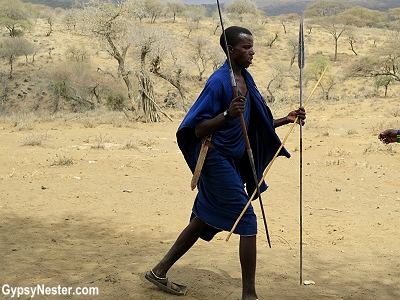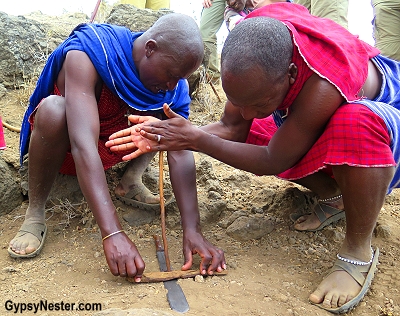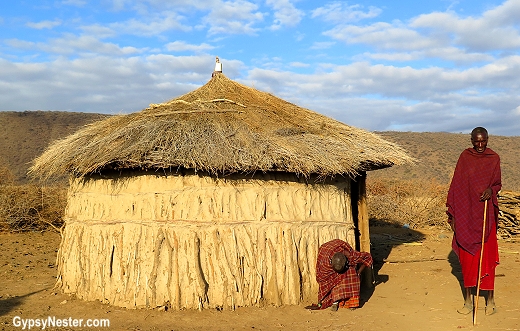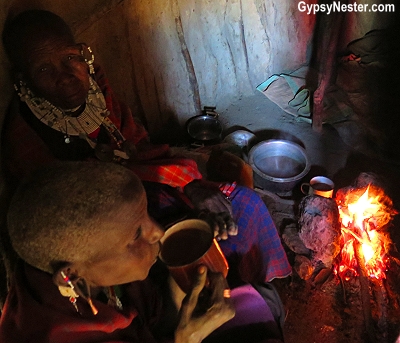

In the Great Rift Valley of Tanzania, Africa we took a journey of hundreds of miles, and a thousand years.
This is a region that has been referred to as the Cradle of Mankind because it was home to homo habilis, likely the first early human species.

No, we couldn’t go back that far — that was about two million years ago — but the Maasai family who had graciously invited us to spend a day with them live a lifestyle unchanged for centuries.
A Man with Eleven Wives

Our team leader, Mama Simba, a brilliant woman who specializes in bringing cultures together in harmonious ways, has worked tirelessly to find a family of the nomadic Maasai willing to share their unique lives with the outside world.

That world is encroaching on the Maasai, but a few families have strived to retain the customs of their forefathers; continuing to tend cattle, goats, and donkeys on their ancestral lands.
We felt it an honor and a privilege to be chosen to visit with them.

Though the Maasai people are relative newcomers to this particular region, having migrated south from Kenya through the Nile Valley over the past few hundred years, they have brought their ancient ways with them.

 Our Discover Corps group traveled way off the beaten path, even by African standards.
Our Discover Corps group traveled way off the beaten path, even by African standards.
After driving many hours from our homebase in the tiny village of Rau, we began to see many of the distinctive huts that these nomadic herders use for shelter.
A group of the shelters belonging to one family, known as inkajijik, are enclosed inside a protective barrier made from the thorny branches of the acacia tree to form a small village called an enkang.

After some precision wheeling along rutted roads through tough terrain, our driver extraordinaire, Zanus, drove the bus completely off the road to take advantage of a small patch of shade near the enkang that was hosting us.


This enkang is headed by a man with eleven wives and over seventy children.
After having asked the exact number of progeny the chief had, we were told that it is not customary for the Maasai to count their children.
But we quickly saw that each and every child was loved and taken care of by the entire family.

WATCH THIS VIDEO!: It’s impossible to fully capture the Maasai through words and photos!
Into the Wilds

After introductions were made, we were invited by two Maasai men to join them for a walk away from the encampment and into the bush.
We were only expecting to see the stark scenery of the valley and learn more about their way of life, but there was also a measure of hopeful excitement at the prospect of seeing giraffe in the backs of our minds.


We had heard that the national animal of Tanzania was known to frequent the area, but after nearly an hour of hiking through the barren, dusty landscape, that hope was waning.
Then our guide pointed out some poop.
It was giraffe, and it was fresh. Let the tracking begin!
The next step was to find some tracks, and the fine soil of ancient volcanic ash was perfect for that.
In no time we were in hot pursuit, making sure to do our best Elmer Fudd impersonations… be verwy-verwy quiet, we’re hunting girwaffe.

Giraffe blend into the bush well, but we spotted our long-necked quarry in some distant trees and picked up the pace in an effort to catch up to them.
Soon we were within a few hundred yards and, while they were wary, they allowed us to observe their stately beauty for quite a while.
We also came upon a small herd of zebras nearby. The moment was magically mesmerizing and no one moved or made a sound.

Suddenly, the spell was broken by something unseen. The animals clearly felt some sort of danger, and both herds broke into a run.
Woah! We watched giraffes gallop off as if they were in slow motion, and felt zebra hoof beats vibrating on the ground beneath us.
Then they were gone and we stood in stunned silence, hardly believing that we had just lived a scene we had only seen on film. (If you skipped the video above, you should go back up and watch it, the “stampede” is there in all its glory!)
A Diet of Meat and Milk… and Blood

Back at the encampment the men were preparing to slaughter a pair of goats down a nearby embankment. This is usually an area where only men are allowed, but an exception was made for our group, since we are not Maasai.
Still, there was more than a little bit of freak out factor involved with witnessing this event, but we also knew that it was a privilege that few will ever see.
Veronica, as a woman, was amazed that she had the opportunity to step foot on the slope where no Maasai female had ever tread.
A slaughter happens only under special circumstances, since both the goats and cattle are used more for their milk than meat. As a matter of fact, the very tall and slender Maasai subsist almost exclusively on milk and meat.

Two teams of two men held each goat down and clamped their hands over the animal’s nose and mouth to suffocate it.
For some reason we expected knives to the throat, so this certainly struck us as a more humane approach, but the method is more about the avoidance of spilled blood.
The blood is an important source of liquid and nutrition in this incredibly harsh and dry environment.

The animals were skinned — the pelts are used for bedding — then internal organs were removed, some of which were eaten on the spot.
As this was done, the blood pooled in the body cavity and several of the men took turns drinking some directly out of the animal.
Nothing was discarded; every bit of the animal is used in one way or another.
WATCH: Learn about the Massai’s ritual goat slaughter and blood drinking (if you’re squeamish, you may want to skip it)

The next step was an obvious one; build a fire to roast the goat.
No matches necessary, the Maasai men made fire by spinning a stick placed on a dry branch.
The friction generated enough heat to create embers that were placed in dry donkey dung.
With a bit of blowing, flames appeared.

Our Discover Corps crew had set up quite a spread for lunch, with fresh goat being the star of the show.
The serving tables were bountifully filled and blankets spread on the ground.
All we had to do was watch the grill and wait, then enjoy an incredible outdoor bar-B-que.
The Birth of Zeus
All morning we had been watching whirlwinds form across the valley. These spinning columns of dust are created when the sun warms the ground causing heated air to rise. The Earth’s rotation sets them spinning like tornadoes, but these are much less powerful.


Still, we wouldn’t want to be in the middle of one.
When one formed not more than a hundred yards from our picnic and headed toward us, we thought we were doomed to find out what the center of a dust devil felt like.
Suddenly Zanus rose up and began walking with his fingers pointed directly toward the approaching enemy shouting MOVE!
To our astonishment the whirlwind obeyed and veered off behind our bus.
We all stood in awe. Were these true powers over nature? We couldn’t be sure, but henceforth we addressed him as Zeus.
Home Life

Dust disaster diverted and appetites appeased, we walked back within the fencing of the enkang for a look inside an inkajijik.
Each of the huts is occupied by one of the wives of the village leader; in this case there are twelve; one for each wife and another for their husband.


The small round buildings are divided into three rooms.
We sat in the main area of one of these while the chief explained the design and Mama Simba translated.
The construction is mostly wooden, and a large support pole holds up a thatched roof, with walls made of branches plastered over with adobe-like cement made from dirt, urine, cow dung, and ashes.

The main room serves as kitchen and meeting area, with storage space and an area where baby goats are brought inside each night. An open fire is used for cooking.
The other two rooms are bed chambers, one of which is occupied by the wife, the other by the children.
The husband does not stay in a wife’s home, he has his own house and the wives take turns accompanying him there. We were told that there is a set visitation schedule and that the wives hold no jealousy.


Since the Maasai are a nomadic people, the entire structure is portable.
It can be dismantled and strapped to a donkey whenever the group needs to move to a new area for grazing the cattle.
Surprisingly, as important as cattle are in the lives of the Maasai, we never saw a single cow.
They were all away grazing, being tended by about half of the group’s members, mostly the younger males (click here to see a young Maasai man we later saw in circumcision garb).
Song and Dance

Just outside of the enkang, women laid out jewelry that they had created.
Making beaded necklaces, bracelets, and earrings has long been a tradition for the Maasai.
Originally they made their own beads, then they began trading with European colonists for them.
Veronica chose an intricate necklace and a wide beaded bracelet with bangles in colors that represent peace and water.

As a farewell, we were treated to a sendoff of song and dance. (If you skipped the video at the top, you should watch it, the singing and dancing are wonderful!)
The men began by performing what is known as the jumping dance while chanting and vocalizing in a low-pitched drone.
They took turns leaping high in the air and heaping much praise on each other’s efforts.


The women followed with call and response songs where a lone woman sings a line and the rest of the group answers in unison.
The two groups continued simultaneously, almost as if they were competing with one another, and then simply stopped.
That seemed to be our cue to be on our way.
We said our goodbyes and boarded our trusty little bus for the journey back our homebase with an incredible amount of new experiences to contemplate.
What Matters Most

We had just lived a true cross-cultural experience, one in which everyone involved was equally as curious about the other.
We shared feelings that defied language differences by using simple gestures that were immediately comfortable, accepted wildly foreign customs without judgment, and celebrated without inhibition.
These are the exchanges that bring us together as a human family, despite our differences.

We learned that it is not how we are different, but how we are the same that matters most.

An invaluable lesson while crossing cultures, boundaries, and a millennium… all in one day.
David & Veronica, GypsyNester.com
A big thank you to Discover Corps for providing this moving cross-cultural opportunity so we can share their good work. As always, all opinions are our own.
Delve Deeper:
See our Tanzanian adventure from the very beginning
Click to see all of our adventures in Africa!




Wow, wow, wow! What an amazing privilege and honour to have been a part of this experience. This is definitely a memory you will treasure the rest of your days!
So true Tanya, certainly unforgettable.
Amazing story and great photography to go along with it. The Maasai people are truly some of the most culturally interesting in the world. Although they all have mobile phones, they live very much like they have for hundreds of years. I love how they are so welcoming and invite travelers into their homes. It will be important for tour operators to ensure this is being done sustainably, with tourist dollars staying in local villages when possible.
Cheers,
Jared
http://www.stridetravel.com
Thanks Jared. Totally agree with what you said about keeping this sustainable and from what we saw at least our visit was done in such a manner. Hope the others are too.
Thank you for sharing your wonderful experience!
What an honor the Masai bestowed on you by slaughtering two of their goats. I appreciated your including the film of this. It was real. I have often thought that if we all had to slaughter our own animals to eat meat, we would eat a lot less of it.
I also wanted to point out that when cultural voyaging, western women are often treated as “honorary men”. As such, we are given access to much the women of the host culture never get to experience.
Bravo for having the curiosity and bravery to voyage cross-culturally. These experiences have made my life immeasurably bigger and better. To learn more about it, I recommend reading anything by Edward Hall.
Great to hear from you Leah! Didn’t know about the honorary men, but that makes sense with how things were handled. Our entire African experience was something that we will never forget, and this day with the Maasai was near the top of it all.
Simply amazing. What incredible photos to go with an unforgettable experience — especially with the Maasai eating (insert gag reflex) live organs.
A little tough to watch, huh? Should have been there in person. 😉
The look on both your faces says it all. What a remarkable experience you shared with the people in Massai. Thanks for sharing it!
That experience is a book in itself, with so much to see and knowledge to gain about the Masai people and culture. What a fascinating glimpse into their lives.
Yes we barely scratched the surface. We have read much more about them since the visit and are fascinated.
Wow, so many experiences with the Maasai, it must have taken a while for it all to sink in. I think the women look so regal with all their adornments. As you say, in spite of the vast culture differences, it’s so cool to notice the things we have in common.
Not even sure that it has all sunk in yet. Every time we look through the photos we find something new.
Your images are fascinating and your words enlightening. I really enjoy reading about your stay with the Maasai.
What an incredible, breathtaking experience. I would love to see them sing together. The photos with the little boy are so special. I could feel the warmth of your two cultures intermingling. Bravo, GypsyNesters! You both did an amazing job with this experience and in your post. Thank you for sharing.
Glad that came across in our story. It was something that we will never forget.
What a great post on the Masai. Great photos and info. Have wanted to go there since Out of Africa. Just finished the new novel about Beryl Markham which took me back there,
It was definitely on our bucket list. Thanks Billie.
What a wonderful experience to visit the traditional world of the Maasai! I really enjoyed reading about them. I love all the photos too. Quite the cross-cultural experience!
It was Donna, and thanks.
We visited the Maasai Mara and were struck with the very traditional way they still lived. Fortunately, safari tourism is often accompanied with economic and social development projects. What a great opportunity you had to really connect with another culture.
It was very cool that we were allowed in such a remote area.
Of all of your adventures, your day with the Masai has to top your list of once-in-a-lifetime experiences and I loved participating just a bit by watching your videos. Fascinating and you’re right, the sharing of cultures did appear to go both ways! Anita
Certainly at, or near the top of that list.
What an incredible experience you had with the Maasai! The slaughtering of the goats is something I’ve never heard of being able to witness. What a way to dive right into a culture.
It certainly was incredible. The credit goes to Mama Simba for setting everything up.
This sounds like it was a very special day with the Masai. My one experience “visiting” the Masai was much less positive: on a safari, we stopped somewhere in the bush and a group of Masai men appeared. They did the jumping dance, visibly unenthusiastic, for the visiting white tourists. Then we were piled back into our van to go to the next stop. It was depressing and unenlightening. It sounds from your videos and description like this took place more in a spirit of equals sharing their cultures.
Yes, I think that they were as curious about us as we were of them.